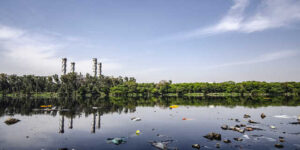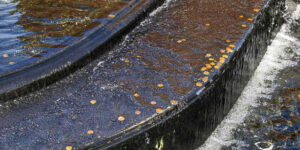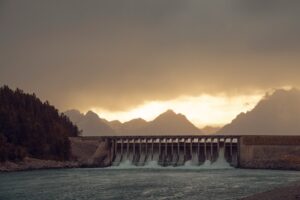Cost of Water Pollution: Our everyday activity affects weather, climate, and the environment. The list of roles that water plays in the life of living beings is endless: solvent, temperature buffer, metabolite, living environment, and lubricants. That’s also what we are polluting when trashing our oceans, rivers, and lakes.
1. Effects on Ecosystems
All around the world living things interact, depending on each other for life. This is what we call ecosystems, and they can be severely changed or destroyed by water pollution. Not only aquatic ecosystems but also terrestrial ones are constantly affected by water and our use of it. A critical part of the global water cycle is forests, wetlands, and grasslands. This continuous movement of freshwater within the Earth and atmosphere ultimately depends on the continued healthy functioning of ecosystems. Is not just the effect water pollution has on each ecosystem separately, but also the global effect it causes because of the interaction between different ecosystems generated by the water cycle.
2. Water Pollution and Biodiversity
One of the most direct effects of water pollution is the disappearance of biodiversity. Water pollution depletes aquatic ecologies and triggers unbridled proliferation of phytoplankton in lakes, which in a balanced ecosystem, provides food for a wide range of sea creatures including shrimp, snails, and jellyfish. The result of this is eutrophic “dead zones”, caused by the promotion of algae growth, where aquatic life cannot survive because of a lack of oxygen.
3. Surface Runoff
In the same line, there’s another silent yet tragic effect of our use of plastic and water. In places where deforestation is a problem, sediment resulting from soil erosion (e.g., silt) can be carried into water bodies by surface runoff. The result of this is that suspended sediment interferes with the penetration of sunlight and upsets the ecological balance of a body of water. Also, when it settles out of suspension it can smother bottom-dwelling organisms, and it is known that it can disrupt the reproductive cycles of fish and other forms of life.
4. Oil Spills
Aquatic species are not only killed by the alterations on the balance of their environment, but also because of more aggressive and instant forms of pollution, such as oil spills. For example, the Deepwater Horizon oil spill in 2010, which stranded and killed many different marine species. One of the most negative effects of oil spills is that they penetrate the structure of the plumage of birds and the fur of mammals, hampering their ability to float and making them more vulnerable to temperature fluctuations. Also, cleanup and recovery from an oil spill is difficult and depends upon many factors, the temperature of the water, for instance, affects evaporation and biodegradation. It is also relevant the type of oil spilled and the types of shorelines and beaches involved.
5. Contamination of Our Food Chain (Cost of Water Pollution)
The concept of ecosystem detailed before helps us understand how we are affected not only by pollution itself but also by the effects that it has on aquatic animals and other food-related activities, such as farming. Every time we fish in polluted waters or use of wastewater for livestock farming and agriculture wen introduce toxins into our food, which are harmful to our health when eaten. When contaminating water, we are also contaminating our food chain. Micro and nano-particles of plastic found in our food once were macro-plastic pollution found in terrestrial and marine environments. These can enter the human food chain either by inhalation or by ingestion, specially of shellfish and crustaceans. Some of the consequences of microplastic exposure are particle toxicity, oxidative stress, inflammatory lesions and increased uptake or translocation. And in long term, the inability of out immune system to remove synthetic particles may increase risk of neoplasia and lead to chronic inflammation.
6. Water Pollution and Drinking Water (Cost of Water Pollution)
In the same line, we not only consume toxins in our food, but also the amount of contaminated water people around the world have every day is scary. Billions of people around the world have no access to good water to drink or sanitation, especially in rural areas. The world is running out of clear water. Half of the world’s population will be living in water-stressed areas in no more than four years. Not only we are finishing the little drinking water we have in the world, but we are also contaminating the one that’s left.
In highly contaminated water zones, people have no option but to drink water polluted by excrement, exposing them to diseases such as dysentery, cholera, and hepatitis A. The WHO estimates that this reality affects about 2 billion people all over the world.
7. Child Death (Cost of Water Pollution)
Children have developing organs and immune systems, smaller bodies and airways, and all this makes them especially vulnerable to dirty air and water. Every year more than 300000 children under 5 years die due to diarrhea, as a result of poor access to clean water, hygiene and sanitation. But are not only the diseases caused by water pollution, but also the deaths that could be prevented through access to clean water, hygiene and sanitation in health facilities as well as reducing pollution.
8. Economic Costs (Cost of Water Pollution)
It costs a lot more to purify water that comes from polluted water bodies. Therefore tourism, agriculture, health systems and many other areas are highly impacted negatively by this growing problem.
These are some of the Cost of Water Pollution
Conclusion
Finally, it’s important not only to consider the different ways water pollution impacts negatively on our reality today, but also the long-term effects it has on our world. In ecosystems that are long term exposed to chemical pollutants, native species die, and the area experiences a loss of diversity becoming more vulnerable to invasive and undesirable species. It is important to bring to our mind that how we take care of our water will impact widely in our future and the next generations’ quality of life, especially considering the accelerated global warming process we are witnessing today. Some of the long-term effects of global warming include accelerated ice melt at the Earth’s poles and the consequent rising sea levels. Less biodiversity, contaminated food and unbalanced ecosystems. Is this the world we want our next generations to live in?
Image by Andrew Martin from Pixabay






Pingback: 10 Common Diseases or Health Complications Related to Water Pollution - nPolluted
Pingback: 10 Harmful Effects of Plastic Bags on The Environment. - nPolluted
Pingback: Understanding the Impact of Small Floodgate Operations on Water Quality in River Networks - nPolluted